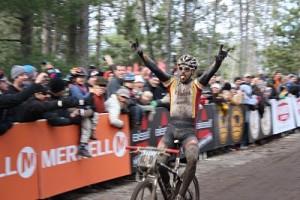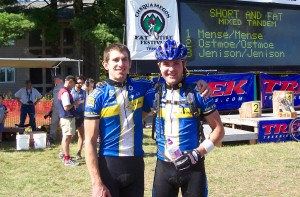Writing up a race report is an opportunity for reflection: what went well, what didn’t, and how do I go about using the experience to pull together a better race next time. So I’m going to briefly reflect on the past two weekends of racing, the good, the bad, and what’s next. The first race was the second UCI MTB World Cup held in Yorkshire, United Kingdom. I raced with the US National Team, so the race support was superb and my teammates were, well, mostly my BMC Mountainbike Development Team USA teammates. Plus, cyclocross superstar Amy Dombroski who is now sprinkling in some mountain bike races with her ‘cross. I can’t thank our race mechanic, USA team manager, or travel companions enough – all fantastic people!
We arrived near Pickering, UK on Thursday morning. On Friday, I got my first couple laps in on the race course. There were two notable spots on the course where I had to stop, consider the lines, and watch some riders negotiate the sections. I had a solid day on the course, the tricky sections dialed, and a World Cup Sprint Eliminator to look forward to that evening. A what? The Sprint Eliminator is formatted with multiple heats – first a qualifying run, then brackets are set up with heats of four riders, semifinals, quarterfinals, etc. The top two riders from each heat proceed onto the next round – until all but four are eliminated before the finals. The course was less than 2 minutes long with three short climbs, a stairway drop, a sketchy dirt corner, and an uphill sprint – my kind of race! I qualified 8th of 20+ racers and went on to finish 8th. In the Small Final, I was on the line with Katerina Nash, Tracey Mosley, Cecile Ravonel (Top-10 World Cup racer, Downhill World Champ, Top-10 World Cup racer) – whoa! I learned that while I can start fast enough for a US ProXCT race, I was left on the start line before I even realized the whistle sounded in every single heat. I need to work on that.
I was confident coming into the cross-country race on Sunday. I felt good, I had trained well, rested up, and was ready to race. My start was good despite a 71st call up position. I lined up along the right barrier, so I was outside of the first sweeping corner—right where I wanted to be. Halfway through lap one, I was riding in 45th. Beginning of lap two, I felt my tire give way on a root and I ‘burped’ some air out. What could have been a minor quick fix with a Big Air (throw in a little extra air so it doesn’t happen again) essentially ended my race. I mentally checked out. I rode the “B” lines to the pit, lost too many positions, took a wheel change I didn’t need, had some shifting problems, had too much tire pressure, hurt my back, and let too much air out only to be back where the problems began . I got pulled before completing my final lap. Ugh, that was not how things should have gone. I let a minor problem end my race.
Monday we traveled to Oberried, Germany (near Freiburg in the Black Forrest region). Freiburg is one of my favorite cities in the world and the riding in the region is incredible. We stayed at Steirebarlehof, a farm with two cats, two pigs, dairy cows, bunnies, ponies, and Emma (the farm dog). Fresh eggs, yogurt, frankfurters, steak, and veggies almost every day—yum! Two good days of training—you would be jealous of the roads! The week was very therapeutic, to say the least. I put Dalby behind me and looked forward to the Offenburg World Cup.
Offenburg is a keep-you-on-your-toes kind of course with lots of euro chutes (steep downhill drop-offs), some good climbs, and technical sections with names like, “Wolf’s Drop” and “Snake Pit.” Spectators pay 15 Euro a piece to watch the race! The course and atmosphere were just that good. I only pre-rode on Friday since we had over an hour long commute from Freiburg. I rode two laps of the course. For the first, I tagged along with the junior and U23 women who were in Freiburg for a USA Cycling Development Camp. We took our time and talked over all the tricky sections. It was very inspiring to see some of these girls muster the courage to try some of these sections which were the most technical trails they’d ever seen. I warmed up for the second lap and then rode a lap near race speed. I pieced together the technical sections fast and flawlessly—I think the talking over the tricky sections helped tremendously. On race day, I rode one of the most consistent races of my career. Every lap was within seconds of each other and my last lap was the fastest. I had no mishaps, was on the verge of cramping for the final two laps, had fun, smiled at spectators who were cheering on the last lap (which always gets more cheers)—I loved it! The first lap was a cluster—and I’ve never been yelled at more in my life. I could probably fight for positions a little bit more, dig a little deeper on lap one and take some more chances. That’s what I’ll work on for the next World Cup in Mt Saint Anne. Until then, I’m happy with my 49th place.
Enjoy the ride,
Chloe


